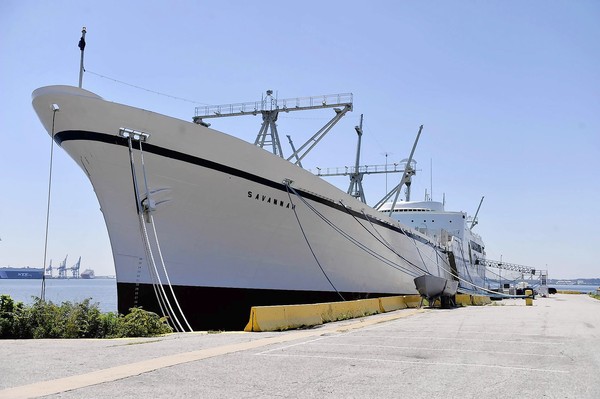Celebrated nuclear ship rests in Baltimore

Tucked behind a ruined grain elevator at a pier along an industrial stretch of Baltimore’s waterfront lies a still-gleaming white vessel that was once one of the nation’s proudest maritime achievements — the only nuclear cargo and passenger ship ever built in the United States.
She’s the N.S. Savannah, a floating time capsule from the mid-20th century that has made Baltimore her retirement home.
For a few brief years during the Kennedy and Johnson administrations she was a nautical superstar, touring the world as an ambassador for the peaceful use of nuclear energy and playing host to royalty. In May 1964 she drew more than 13,000 visitors during a call at Dundalk Marine Terminal.
But she faded from the scene like a doo-wop group pushed aside by the Beatles.
“She was a very interesting ship … in her time,” said former U.S. Rep. Helen Delich Bentley, who as The Baltimore Sun’s maritime editor wrote about the Savannah in the ship’s heyday. “She was really the grande dame on the oceans.”
Unlike the Constellation, the Savannah is not a floating museum or a tourist attraction. She is berthed not in the Inner Harbor but at out-of-the-way Pier 13, near the Seagirt Marine Terminal, wedged between a coal terminal and a gypsum plant that combine to keep her coated with layers of black and white dust.
Still owned and maintained by the Federal Maritime Administration and regulated by the Nuclear Regulatory Commission, she is opened to visitors on occasions such as the Maritime Day celebration each May. Groups can arrange tours by request, as long as they don’t expect too much in the way of air conditioning, elevators or other modern creature comforts.
Some of the ship’s fans dream of turning her into an active cultural and educational treasure, but so far nobody has figured out where the money would come from.
Erhard W. Koehler, the ship’s programs manager and full-time cheerleader, said the Savannah is the only U.S. vessel ever to have borne the prefix N.S., for nuclear ship, though a few other countries also had such ships. He said the vessel was conceived in 1955 by President Dwight D. Eisenhower to promote his vision of a world in which nuclear power was put to nonmilitary use — a program known as Atoms for Peace.
“It was the one thing in the program that fulfilled Eisenhower’s vision to promote peaceful uses of nuclear power to the world,” said Koehler, who has worked aboard the ship since 1993.
Koehler said nuclear power production was discontinued in 1971 when the ship was taken out of service. Residual radioactivity levels are very low, he said, even though the facility will remain under a regulatory regimen that applies to nuclear power plants until 2031.
“Low risk does not mean no risk,” he said. “We always treat this facility with a healthy respect.”
The Savannah, a sleek 5951/2 feet long and 78 feet wide, was built at a cost of $47.6 million to be the Atoms for Peace flagship. The ship was named after the S.S. Savannah, which in 1819 became the first ship to cross the Atlantic using steam power.
The N.S. Savannah was built in the shipyards of Camden, N.J., and Bentley, then Helen Delich, covered the story when the vice president’s wife, Patricia Nixon, waved a radioactive wand to mark the start of work to lay the ship’s keel. A year later, Delich was there when Mamie Eisenhower “gave a lusty swing to the bottle of champagne and cracked it on her first try” at the Savannah’s christening.
According to Koehler, the Savannah was never intended to make money. He said Eisenhower personally directed that it be designed with aesthetics rather than profitability in mind. To that end, the designers installed fewer booms than on a conventional cargo ship — complicating loading and unloading but preserving the vessel’s clean lines.
The ship was completed in 1961 and generated its first nuclear power late that year. In 1962, the Savannah made her maiden voyage from Savannah, Ga., to Norfolk, Va. Koehler said the ship carried 60 passengers at full capacity.
A visitor touring the Savannah enters the era of the Rat Pack and Jackie Kennedy’s pillbox hats, with Jetsons-style furniture and ceiling lamps with atomic power symbols worked into the design. Some artifacts of the era are amazingly well preserved, such as the bar in the passenger lounge and a collection of the ship’s china. Others are in serious disrepair, such as the upholstery in the passengers’ dining room.
Outside the lounge is a deck where passengers once swam in the pool, now covered over, or played shuffleboard.
Some of the best-preserved sections are on the business end of the ship. Equipment on the bridge is mostly original, including a high captain’s chair made for the slightly built original skipper, Koehler said. The galley has an early generation of microwave oven so the ship’s cooks could “nuke” food long before that shortcut became commonplace in American homes.
Shortlink:
